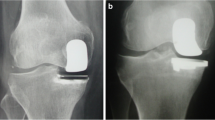Abstract
Purpose
The purpose of this study was to assess tibial post-fracture between highly cross-linked polyethylene (HXPE) and conventional polyethylene inserts in consecutive posterior-stabilized (PS) total knee arthroplasty (TKA) over a minimum 12-year follow-up period.
Methods
Between January 2007 and June 2008, a consecutive series of 2446 primary TKAs was performed in 1478 patients at a single institution. The final cohort was classified into two groups (1559 in the HXPE group and 887 in the conventional group) based on the insert material used during the procedure.
Results
The mean follow-up period was 13.1 years in the HXPE group and 13.4 years in the conventional group. All 16 cases of tibial post-fracture occurred in the HXPE group. This complication rate was 1.03%. The mean elapsed time from primary TKA to the diagnosis of post-fracture was 3.9 years (range 0.5–10.0 years). Ten cases required replacement with a thicker polyethylene insert, and six cases underwent tibial revision surgery. There were no cases of tibial post-fracture in the conventional group.
Conclusion
Tibial post-fracture is not a rare complication in PS TKA with HXPE. Therefore, the possibility of a tibial post-fracture should be considered if newly developed pain, acute subluxation, effusion, patellar clunking, or instability occurs in patients treated with PS Scorpio knee system TKA using an HXPE insert.
Level of evidence
IV.


Similar content being viewed by others
References
Banks SA, Harman MK, Hodge WA (2002) Mechanism of anterior impingement damage in total knee arthroplasty. J Bone Joint Surg Am 84-A(Suppl 2):37–42
Callaghan JJ, O’Rourke MR, Goetz DD, Schmalzried TP, Campbell PA, Johnston RC (2002) Tibial post impingement in posterior-stabilized total knee arthroplasty. Clin Orthop Relat Res 404:83–88
Chiu YS, Chen WM, Huang CK, Chiang CC, Chen TH (2004) Fracture of the polyethylene tibial post in a nexgen posterior-stabilized knee prosthesis. J Arthroplasty 19(8):1045–1049
Diamond OJ, Howard L, Masri B (2018) Five cases of tibial post fracture in posterior stabilized total knee arthroplasty using prolong highly cross-linked polyethylene. Knee 25(4):657–662
Dorr LD, Ochsner JL, Gronley J, Perry J (1988) Functional comparison of posterior cruciate-retained versus cruciate-sacrificed total knee arthroplasty. Clin Orthop Relat Res 236:36–43
Hendel D, Garti A, Weisbort M (2003) Fracture of the central polyethylene tibial spine in posterior stabilized total knee arthroplasty. J Arthroplasty 18(5):672–674
Jung KA, Lee SC, Hwang SH, Kim SM (2008) Fracture of a second-generation highly cross-linked UHMWPE tibial post in a posterior-stabilized scorpio knee system. Orthopedics 31(11):1137–1139
Jung KA, Lee SC, Hwang SH, Kim SM (2009) Fractured polyethylene tibial post in a posterior-stabilized knee prosthesis presenting as a floating palpable mass. J Knee Surg 22(4):374–376
Kester MA, Herrera L, Wang A, Essner A (2007) Knee bearing technology: where is technology taking us? J Arthroplasty 22(7 Suppl 3):16–20
Khan M, Osman K, Green G, Haddad FS (2016) The epidemiology of failure in total knee arthroplasty: avoiding your next revision. Bone Joint J 98-B((1 Suppl A)):105–112
Lachiewicz PF (2011) How to treat a tibial post fracture in total knee arthroplasty? a systematic review. Clin Orthop Relat Res 469(6):1709–1715
Mariconda M, Lotti G, Milano C (2000) Fracture of posterior-stablized tibial insert in a genesis knee prosthesis. J Arthroplasty 15(4):529–530
Mathis DT, Hirschmann MT (2020) Why do knees after total knee arthroplasty fail in different parts of the world? J Orthop 23:52–59
Mauerhan DR (2003) Fracture of the polyethylene tibial post in a posterior cruciate-substituting total knee arthroplasty mimicking patellar clunk syndrome: a report of 5 cases. J Arthroplasty 18(7):942–945
Mestha P, Shenava Y, D’Arcy JC (2000) Fracture of the polyethylene tibial post in posterior stabilized (Insall Burstein II) total knee arthroplasty. J Arthroplasty 15(6):814–815
Puloski SK, McCalden RW, MacDonald SJ, Rorabeck CH, Bourne RB (2001) Tibial post wear in posterior stabilized total knee arthroplasty an unrecognized source of polyethylene debris. J Bone Joint Surg Am 83(3):390–397
Ritter MA, Campbell E, Faris PM, Keating EM (1989) Long-term survival analysis of the posterior cruciate condylar total knee arthroplasty a 10-year evaluation. J Arthroplasty 4(4):293–296
Shih KC, Chou LC (2007) Fracture of the polyethylene tibial spine in nexGen posterior stabilized flex knee prosthesis: a case report. J Orthop Surg Taiwan 24:30–34
Funding
Not applicable.
Author information
Authors and Affiliations
Corresponding author
Ethics declarations
Conflict of interest
Each author certifies that he or she has no commercial association (eg. consultancies, stock ownership, equity interest, patent, licensing arrangements, etc.) that might pose a conflict of interest in connection with the submitted article.
Ethical approval
The design and protocol of this retrospective study were approved by the Institutional Review Board of our hospital, which waived the requirement for informed consent.
Additional information
Publisher's Note
Springer Nature remains neutral with regard to jurisdictional claims in published maps and institutional affiliations.
Rights and permissions
About this article
Cite this article
Baek, JH., Lee, S.C., Choi, K. et al. High rate of tibial post-fracture in highly cross-linked polyethylene compared to conventional polyethylene in posterior-stabilized total knee arthroplasty at a minimum 12-year follow-up. Knee Surg Sports Traumatol Arthrosc 30, 4072–4077 (2022). https://doi.org/10.1007/s00167-022-06901-y
Received:
Accepted:
Published:
Issue Date:
DOI: https://doi.org/10.1007/s00167-022-06901-y




